I had the pleasure of attending a wicking bed workshop yesterday at my friend Michael’s. He recently purchased a new home, which has a monstrous backyard. I believe that it is about 1400 square metres in area, which is just the right size for a food gardener as passionate as he is.
The garden beds are made from a hardwood, 5 metres by 1.2 metres. They are massive.
At the bottom of each bed is a level base of clean sand for the lining to rest upon, and so that no stones pierce a hole through it when the weight of all the gravel and compost is in the bed.
Michael had already stapled the liner to one of the two beds that he and his family had constructed. We then laid down the geo-textile, which assists with the wicking action.
Here is Carmen and Bunty posing in front of the bed before we placed down the fabric. Lovely ladies, and both keen gardeners.
This is the second bed, which we managed to partly finish. It doesn’t show in this picture, but we managed to staple in the liner ready for the fabric and watering tube.

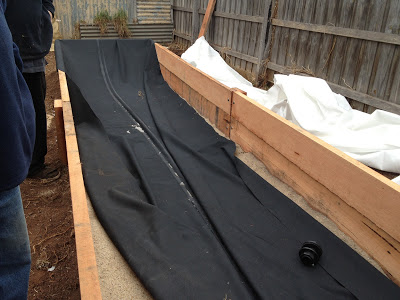

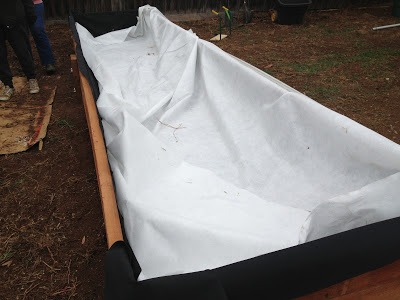
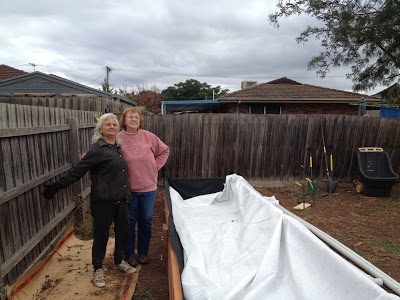
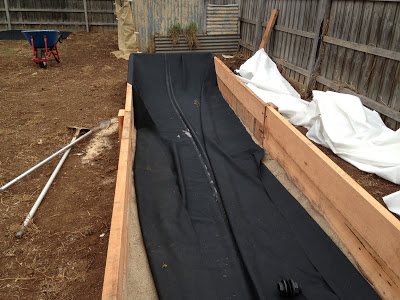
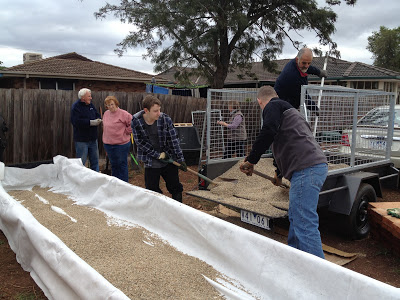
Great Post Gav. Wow, that’s a lot of land to play with and massive beds. Jealous
I have two 3m X 1m beds and three 1m X 1m beds. I also have multiple wicking boxes on my front porch for herbs, leafy greens and garlic.
I just use compost/potting mix in the wicking boxes, but the beds are constructed on a similar principle to the ones you made, except mine have an actual water reservoir embedded in the sand below, with the watering tube attached to that.
I’ve had mine for a couple of years now and I wouldn’t garden any other way now. Exxy to set up and hard work, but such a dream to work with over summer. I had planta leaping out of these beds with produce, while my in-ground garden suffered.
I did an update on my wicking boxes yesterday, as it happens…http://dancingwithfrogs.wordpress.com/2013/05/19/skinflint-sunday-fun-with-potting-mix/
I learned how to make the wicking boxes from http://foodnstuff.wordpress.com
Allow 30cm for the soil… no more than that or the plants’ roots can’t reach the water to ‘wick’ it up. )
I’m turning this comment into a blog post so I’ll go now…
Greetings,
We’re using wicking for a range of applications including to reclaim our nature strips. Not only will they be able to survive better against the hot western sun in summer. They are also easier to maintain which is really important on a nature strip because nothing looks better than a box bursting with green but nothing looks worse than a box full of sterile dust!.
We have been building our beds from reclaimed pallet wood that was donated by a local bulk pet food store (they even delivered them rather than dumping them). We’ve been experimenting with a couple of different approaches,like using scoria rather than sadn, or only building the edging out of wood and then digging a hole below the box to make the box less imposing but still give you a good size of reservoir.
One of the best things about this project though was that we decided to paint 3 of the panels in blackboard paint and staple a pot-plant full of chalk to the side. This has become a notice board, childrens art space and even advertising board for local community actions and makes me smile every time I walk past.
I don’t seem to able to attach photo’s to this reply but you can see some (slightly old) pics at http://treadinglightlyblog.com/2013/05/08/reclaiming-our-curb/
Cheers,
Paul.
Hi Gav,
I have a 3 wicking beds and three wicking tubs (method also learned from FoodnStuff). The beds are eco-wood (treated pine) and use scoria as the reservoir. Scoria is full of air holes so you get a lot of water holding capacity.
My first bed was 400mm high (two sleepers) but I dug down into the earth to increase the size of the reservoir. The two newer ones are 600mm high. All have a 300mm of soil although that rises and falls a bit as the beds are refilled and compact.
I’d advise anyone embarking on wicking beds that the soil can take a little while to develop. My newer beds (7 months old) are still a little dry and don’t wick as well as they should. I probably didn’t have enough organic matter in the mix. They will improve with the mixing in of the past season’s mulch. The older bed (18 months old) was initially the same but now has has incredible soil. It has had several seasons of mulch dug through as well as a few top-ups of manure.
The difference in growth rates and stress signs between wicking beds and my regular raised bed is really clear. I do wonder though if plants like tomatoes are a little more inclined towards viruses since they never get a chance to dry out? I’m not experienced enough yet to say.
My tips:
1. Incorporate a worm feeding station into the design and add compost worms. I’m certainly not the inventor of this and have read many blogs about doing the same. I use a length of 150mm PVC pipe with an inspection cap as a tight (read: toddler-proof) lid. The pipe has holes drilled in below the soil level. They were kicked off with some composting worms and receive kitchen scraps frequently. The oldest wicking bed is now chock fill of worms. I think the worms churning the soil and leaving their castings are what makes it wick so well.
The new beds have worms too but it takes time for the numbers to build up to the many thousands.
Worms this way would not be as efficient at scrap disposal as a dedicated worm farm but they are zero maintenance, being able to wander off to nibble manure mulch if you don’t feed them enough and they can crawl up or down to find a comfortable temperature. They can go for weeks without attention.
I once went out in a really heavy downpour when the wicking bed was struggling to dispel the water fast enough. The wall of the garage had hundreds of worms climbing it. They were escaping the temporary flood and looked like a scene from a science-fiction movie.
2. Plan how you’ll stake the bed for plants that need support. You don’t want to drive a stake through the membrane base but you probably don’t want to pierce the cloth that keeps the weeds out of the stones either. 300mm of damp soil does not provide a lot of stability for a 2.5 metre tomato.
I’ve tried two methods: fixing a hardwood stake scaffolding to the outside of the bed and using bamboo. I’ve ended up making the scaffolding permanent on one bed since there are so many climbing veggies. I use coir string for each crop so I can just chop it down and add it to the compost.
In my newer beds I planned ahead and put short (perhaps 50-100mm) lengths of 25mm pipe at even spacing around the inside rim of the bed (held with gal strap impersonating pipe clips). That allows me to “drop in” the scaffolding. It was really satisfying to lift out the frame used to support tomatoes (a very tall frame on each side and with cross bracing) and put in a flat frame with a grid of string for winter peas in just a couple of minutes. The frames are bamboo joined with wire and they lay flat on my garage roof when not being used. As they are not sunk deep into the soil they stay dry and rot less.
The pipes around the rim are also perfect for holding the ends of poly-pipe hoops to build mesh tunnels for brassicas.
Looks like I went a bit more over-board than FrogDancer. I think those inclined towards wicking beds get a bit evangelical about their merits!
All the best.
One more thing Gav, are you sure about your measurement of the gravel? The whole bed only looks 40cm high. Or did you completely fill that and add more timber before the soil?
I attended a wicking bed workshop in Kyneton last year where they turned an apple crate into a wicking bed. We opted against them (not sure I remember why now) but the idea of using the apple crate is what inspired me to use crates for growing spuds. 🙂
Wow..great post and loving all of your blog readers who have a wealth of wicking experience. The worm stations that Cameron mentioned are fantastic for any raised bed. I find that the cheap dodgy way works too…where I just bury kitchen scraps (marked in the ground with a bamboo pole…so I know where to put them)and as Cameron mentioned starting it off with some worms). Great reading – both yours and the comment-makers.
I have wicking beds as well, great in summer when it is such a waste watering the top of the soil. We also put charcoal (biochar) along the pipe and use a layering method. Gavin can you tell me where to order the geotextile from, I have used plastic in the past but that was not great. Thanks
Not sure Penny. Send me an email and I will check with my friend.
Gav x
Thanks for all your comments and extra tips. I LOVE the interaction. Who says you can’t have a community online!
Gav